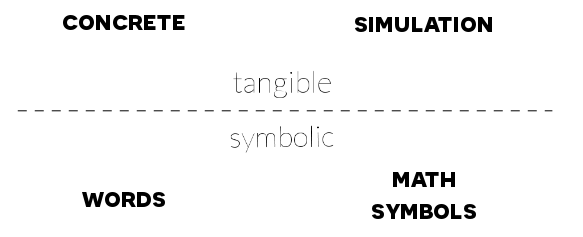We need people who can make tangible changes to our world using mathematics. This post outlines a framework for achieving that.
The modern world is a mechanical symphony. Our days are rhythmically organized into time slots where we interact with systems that have been designed using mathematics. We wake up to the sound of a programmed clock and make coffee with a machine that precisely regulates the temperature and flow rate of water. Our mail comes like clockwork, efficiently finding its way to our homes because our address is one element in an efficiently nested set: house numbers within streets within towns within zip codes within states. We drive to work in moving, mathematical sculptures. Our cars are intricate systems of metal and electronics that are designed almost entirely in mathematical software programs and fine-tuned using statistical analyses of performance.
Every element of our life and work is governed primarily by systems that have been designed by people who think mathematically. And that means that there are two types of people in this world: those that help design the systems that they live within and those that simply live within the systems that other people have designed for them. Facility with mathematics is, more than any other, the skill that separates the two groups.
Mathematics is the language of design and the language of the universe. The following video helps drive this point home.
Every country in the world expends extensive resources teaching mathematics. It is a matter of life and death. We exhaust so much of our time and energy teaching it because it helps us move mountains, build faster planes, produce more engaging toys, grow more food, and develop medicines that save our kids’ lives. It is true that mathematics is absolutely beautiful, maybe the most beautiful thing in the world. But that is not why countries exhaust so much of their time and energy teaching it. We teach it because it helps us move physical matter around in ways that have tangible effects on our lives.
What is our goal as math educators, then? For me, it has become clear. Our goal is to produce people who can move matter with mathematics. To produce people who can take physical stuff and make it do precise things that have been structured and defined using mathematics. This is an exciting realization for a couple reasons. First, the goal is clear and simply stated, which makes developing a plan for achieving it easier. Second, it brings mathematics out of the realm of the abstract and into the realm of the concrete, which has the potential to engage more learners and connect mathematics with a much wider range of experiences.
The Manifest Framework
The Manifest Framework, in a nutshell, systematically mixes mathematical ideas with physical matter and teaches learners to express those mathematical ideas in terms of the physical matter in four ways: in words, in mathematical symbols, as simulations, and in concrete ways. These can be arranged like this:

This separates them into two groups, with symbolic representations of the concept on the bottom and tangible representations of the concept on top.

To apply the Manifest Framework, first select a mathematical idea. Next, select some physical matter. We do this by selecting a unit of measure, and, if necessary, an object that will be measured by that unit. If you select “zebras” as your unit of measure, you’re done, since zebras are physical matter. If you select “inches”, however, you need to be more specific. You also have to select an object that will be measured in inches, like a stick, or a person, or a blades of grass.
So, in short, you select a mathematical idea and a unit of measure (physical matter). Then you start working with the four expressions. For instance, you might select unit fractions as your mathematical idea, and apples as your unit of measure. If you do, your instructional experience would consist of having students represent unit fraction amounts of apples in words, math symbols, simulations, and real apples. Much of the instruction, in this case, would revolve around teaching learners specific strategies for cutting apples (or mashing and portioning, or…) in ways that produce different unit fraction amounts of apples, and letting them practice and master those techniques.
In addition to representing each of the modes individually, learners are also expected to translate between the four. If a learner is given a mathematical idea represented in words, for instance, they are expected to be able to:
- recreate the word representation itself
- translate it into math symbols
- translate it into simulation form
- translate it into concrete form
Given that there are four representation modes, and that learners are expected to be able to perform four different tasks given a math idea presented in each mode (recreate the mode itself + translate it into the other 3 modes), that means that, given a single mathematical idea and single unit of measure, there are 16 unique skills that a learner needs to master in order to become proficient in that math idea/physical matter pair. Here is a visualization of the 16 skills:

In order to get a better handle on this, let’s look more closely at a specific example. In this example, we’ll select quadratic functions in vertex form as our mathematical idea. Since functions have two variables, we need to select two units of measure: one for the input variable and one for the output variable. We’ll let the input be time, in seconds, and the output be rotations, in degrees. And finally, we need to select a concrete object that will be rotating over time. For our purposes, we’ll select one of the trendiest toys going right now: the fidget spinner.
To be specific, let’s consider the function . Here is what each of the four representations look like in this case:
Math Symbols
This one is easy since it is the one we started with. The math symbols for this situation are simply:
Simulation
Here is a simulation for the spinner context. It allows you to input any function of and see how that function expresses itself as rotations of the spinner over time. It is currently set to our target function
over the interval 0 – 4 seconds. Before you press the play button to watch how the rotations play out over time, take a second to make a prediction. What will happen when you press play? When you’re ready, press play in the bottom left corner to see what happens.
When you’re done, I encourage you to play around a bit with this simulation. To try a different function, you’ll have to pause the simulation, enter a new function, and press play again. While its paused, you can also change the time interval and see how that effects things. When you’re done, move on to the next section, where we’ll look at actual fidget spinners rotating according to this function.
Concrete
A concrete instance, in this situation, is a real fidget spinner performing the rotational story described by the function. Since I can’t perform it live for every reader, here’s a video of this function expressing itself as spinner rotations over time, as well as a few other functions being realized.
Words
And finally, here is precise language that describes the same story as the function:
The spinner rotates in the negative direction at a decreasing speed from 2400 degrees to 0 degrees from 0 seconds to 2 seconds. At 2 seconds, the spinner reverses direction and rotates in the positive direction at an increasing speed from 0 degrees to 2400 degrees from 2 seconds to 4 seconds.
Now that we have an understanding of what each of the four representations look like, it’s time to see what a full learning experience that successfully teaches learners to master all 16 skills associated with quadratic functions that govern rotations of a fidget spinner over time looks like. Introducing…
Spinner Math
Part gimmick, part world-class math experience, Spinner Math is a tour de force that highlights the revolutionary potential of simulations in math education. Here is a link to the homepage for the experience:
There you will find classroom handouts, videos, simulations, and interactive tasks that are carefully woven together to efficiently achieve the goals set out by The Manifest Framework for this context. Not only does it cover quadratic functions, it also covers basic linear functions, sine functions, and functions defined using integrals, with custom materials for each of these domains.
I genuinely think you will find the experience to be fulfilling and valuable.
Summary
I believe The Manifest Framework has a lot to offer the field of math education. It is well-defined and easy to understand. It can be used on topics ranging from whole numbers to differential equations, and it focuses wholeheartedly on the meaning of the mathematics being studied. The world needs people who can make tangible changes to our world using mathematics. The Manifest Framework systematically accomplishes the goal of producing learners who can.
I am really interested in hearing your feedback on both The Manifest Framework as well as the Spinner Math experience itself. Please comment. Share it with other teachers. Figure out other ways to use it. Try it with your students. Post classroom action to #spinnermath and #manifestmath. Future posts will be dedicated to developing more materials for more contexts and looking at how the work of others within the MTBoS fit within the framework. I look forward to fleshing it all out together.

0 Comments